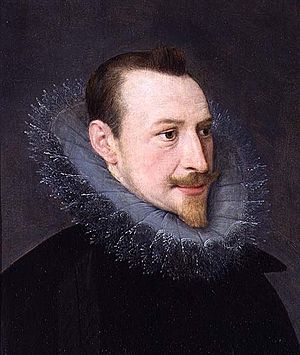Spenserian stanza facts for kids
The Spenserian stanza is a special way of writing poetry. It was created by an English poet named Edmund Spenser for his long poem, The Faerie Queene. Each Spenserian stanza has nine lines. The first eight lines have a rhythm called iambic pentameter, which means they usually have ten syllables. The last line is a bit longer, called an alexandrine, and it has twelve syllables. The words at the end of the lines follow a specific rhyming pattern: a-b-a-b-b-c-b-c-c.
Contents
What is a Spenserian Stanza?
A Spenserian stanza is like a building block for a poem. It's a set group of nine lines that follow very specific rules for their length and how they rhyme. Spenser made this form unique, and it gives poems a grand, flowing sound.
How It's Built: Rhyme and Rhythm
The way a Spenserian stanza is put together is very precise. It uses a mix of shorter and longer lines, along with a special rhyme pattern, to create its musical effect.
Iambic Pentameter Explained
Most of the lines in a Spenserian stanza are written in something called iambic pentameter. This means each line has ten syllables, and they follow a "da-DUM da-DUM" rhythm. Think of it like a heartbeat: "I AM a PO-et, STRONG and TRUE." This rhythm makes the lines sound natural and flowing.
What is an Alexandrine?
The ninth and final line of a Spenserian stanza is an alexandrine. This line is longer, with twelve syllables, and it also follows a "da-DUM" rhythm. This longer line often gives the stanza a feeling of completion or a grand finish, like a final flourish.
Who Used the Spenserian Stanza?
After Edmund Spenser created this special stanza, many other famous poets used it in their own works.
Famous English Poets
The Spenserian stanza became very popular with English poets. Some well-known writers who used it include:
- Lord Byron in his poem Childe Harold's Pilgrimage
- Percy Bysshe Shelley in Adonais
- John Keats in The Eve of St. Agnes
- Alfred, Lord Tennyson in The Lotos-Eaters
Poets Outside England
While the Spenserian stanza was mostly popular in England, a few poets in other parts of Europe also used it. For example, Juliusz Słowacki, Jan Kasprowicz, and Jaroslav Vrchlický from Central Europe tried this form.
See also
 In Spanish: Estancia spenseriana para niños
In Spanish: Estancia spenseriana para niños


